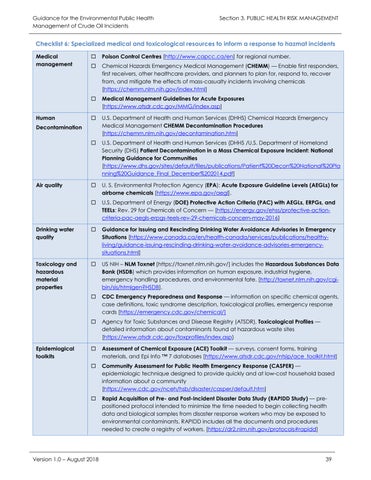Guidance for the Environmental Public Health Management of Crude Oil Incidents
Section 3. PUBLIC HEALTH RISK MANAGEMENT
Checklist 6: Specialized medical and toxicological resources to inform a response to hazmat incidents Medical management
Poison Control Centres [http://www.capcc.ca/en] for regional number.
Chemical Hazards Emergency Medical Management (CHEMM) — Enable first responders, first receivers, other healthcare providers, and planners to plan for, respond to, recover from, and mitigate the effects of mass-casualty incidents involving chemicals [https://chemm.nlm.nih.gov/index.html]
Medical Management Guidelines for Acute Exposures [https://www.atsdr.cdc.gov/MMG/index.asp]
U.S. Department of Health and Human Services (DHHS) Chemical Hazards Emergency Medical Management CHEMM Decontamination Procedures [https://chemm.nlm.nih.gov/decontamination.htm]
U.S. Department of Health and Human Services (DHHS /U.S. Department of Homeland Security (DHS) Patient Decontamination in a Mass Chemical Exposure Incident: National Planning Guidance for Communities [https://www.dhs.gov/sites/default/files/publications/Patient%20Decon%20National%20Pla nning%20Guidance_Final_December%202014.pdf]
U. S. Environmental Protection Agency (EPA): Acute Exposure Guideline Levels (AEGLs) for airborne chemicals [https://www.epa.gov/aegl].
U.S. Department of Energy (DOE) Protective Action Criteria (PAC) with AEGLs, ERPGs, and TEELs: Rev. 29 for Chemicals of Concern — [https://energy.gov/ehss/protective-actioncriteria-pac-aegls-erpgs-teels-rev-29-chemicals-concern-may-2016]
Drinking water quality
Guidance for Issuing and Rescinding Drinking Water Avoidance Advisories in Emergency Situations [https://www.canada.ca/en/health-canada/services/publications/healthyliving/guidance-issuing-rescinding-drinking-water-avoidance-advisories-emergencysituations.html]
Toxicology and hazardous material properties
US NIH – NLM Toxnet [https://toxnet.nlm.nih.gov/] includes the Hazardous Substances Data Bank (HSDB) which provides information on human exposure, industrial hygiene, emergency handling procedures, and environmental fate. [http://toxnet.nlm.nih.gov/cgibin/sis/htmlgen?HSDB].
CDC Emergency Preparedness and Response — information on specific chemical agents, case definitions, toxic syndrome description, toxicological profiles, emergency response cards [https://emergency.cdc.gov/chemical/]
Agency for Toxic Substances and Disease Registry (ATSDR), Toxicological Profiles — detailed information about contaminants found at hazardous waste sites [https://www.atsdr.cdc.gov/toxprofiles/index.asp)
Assessment of Chemical Exposure (ACE) Toolkit — surveys, consent forms, training materials, and Epi Info ™ 7 databases [https://www.atsdr.cdc.gov/ntsip/ace_toolkit.html]
Community Assessment for Public Health Emergency Response (CASPER) — epidemiologic technique designed to provide quickly and at low-cost household based information about a community [https://www.cdc.gov/nceh/hsb/disaster/casper/default.htm]
Rapid Acquisition of Pre- and Post-Incident Disaster Data Study (RAPIDD Study) — prepositioned protocol intended to minimize the time needed to begin collecting health data and biological samples from disaster response workers who may be exposed to environmental contaminants. RAPIDD includes all the documents and procedures needed to create a registry of workers. [https://dr2.nlm.nih.gov/protocols#rapidd]
Human Decontamination
Air quality
Epidemiogical toolkits
Version 1.0 – August 2018
39







